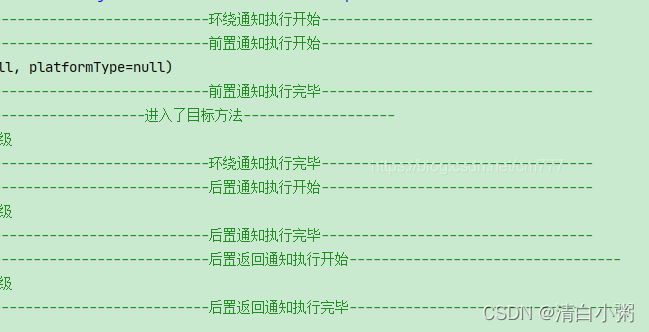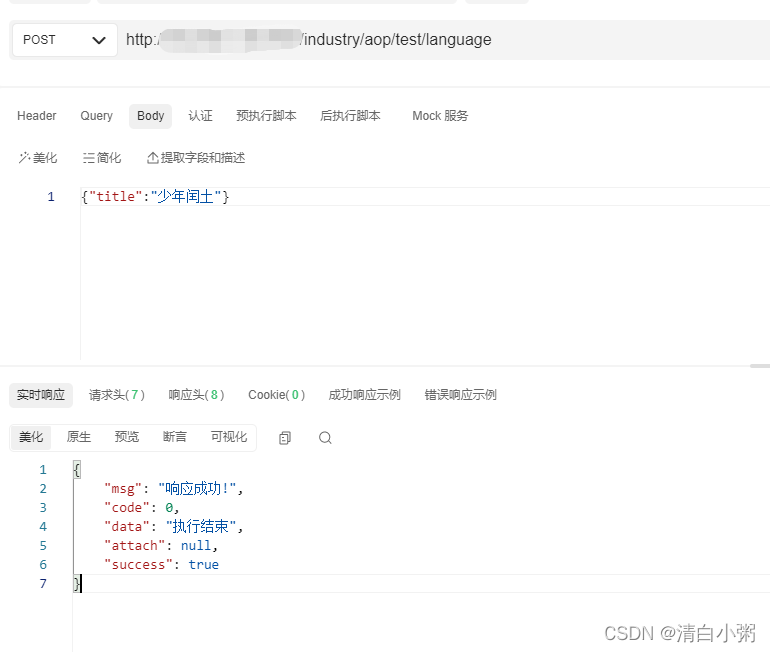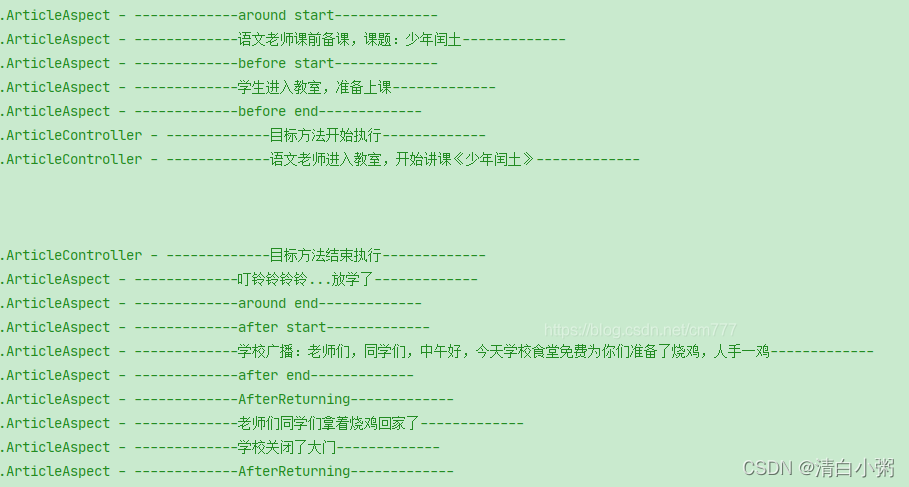Spring AOP有多少个通知以及它们的执行顺序介绍
滕青山YYDS 人气:0Spring AOP有多少个通知以及它们的执行顺序
Spring AOP有多少个通知
- ①前置通知(Before):在连接点执行前执行该通知
- ②正常返回通知(AfterReturning):在连接点正常执行完后执行该通知,若目标方法执行异常则不会执行该通知
- ③异常通知(AfterThrowing):在连接点执行抛出异常时执行该通知
- ④后置通知(after/finally):在连接点执行完成后(不管成功、失败、异常)都会执行该通知
- ⑤环绕通知(Around):围绕在连接点前后
Spring AOP通知的执行顺序
- ①环绕通知:@Around
- ②前置通知:@Before
- ③执行连接点方法
- ④环绕通知:@Around
- ⑤后置通知:@After
- ⑥正常返回通知:@AfterReturning,如果发生异常那么就是异常通知@AfterThrowing

SpringAOP简单案例
本文是一个老师在学校给学生上课的简单案例,介绍了AOP的五个通知的使用,以及通知的执行顺序。通过自定义注解来充当切入点,获取注解的类型分别对不同的老师做对应的业务处理。
代码中的消息响应体(Result)大家可以自定义类型。
AOP的五大通知
- 前置通知:Before
- 环绕通知:Around
- 后置通知:After
- 后置返回通知:AfterReturning
- 后置异常通知:AfterThrowing
执行顺序如下图所示:

AOP的使用方式
1.创建一个课题实体对象
package com.cloud.industryapi.test;
import lombok.Data;
/**
* 课题实体
* @date 2022/3/25 16:26
*/
@Data
public class ArticleEntity {
/**
* PK
*/
private Integer id;
/**
* 课题
*/
private String title;
/**
* 内容
*/
private String content;
}2.定义一个切入点,这里以自定义注解的方式实现
package com.cloud.industryapi.test;
import java.lang.annotation.*;
/**
* 切点标识
* @author
* @date 2022/3/25 13:09
*/
@Target({ElementType.METHOD,ElementType.PARAMETER})
@Retention(RetentionPolicy.RUNTIME)
@Documented
public @interface PointcutId {
String type() default "";
}3.声明要织入的切面
package com.cloud.industryapi.test;
import lombok.extern.slf4j.Slf4j;
import org.aspectj.lang.JoinPoint;
import org.aspectj.lang.ProceedingJoinPoint;
import org.aspectj.lang.annotation.*;
import org.springframework.stereotype.Component;
/**
* 切面
*/
@Slf4j
@Aspect
@Component
public class ArticleAspect {
/**
* 定义切入点
*/
@Pointcut("@annotation(com.cloud.industryapi.test.PointcutId)")
public void pointcut(){
}
/**
* 环绕通知
* @param joinPoint
* @param id
* @return
* @throws Throwable
*/
@Around("pointcut() && @annotation(id)")
public Object around(ProceedingJoinPoint joinPoint, PointcutId id) throws Throwable {
log.info("-------------around start-------------");
Object[] objects = joinPoint.getArgs();
switch (id.type()){
case "language":
ArticleEntity language = (ArticleEntity) objects[0];
log.info("-------------语文老师课前备课,课题:{}-------------",language.getTitle());
break;
case "mathematics":
log.info("-------------数学老师课前备课-------------");
break;
default:
throw new RuntimeException("类型非法");
}
//joinPoint.proceed()
Object s = joinPoint.proceed();
log.info("-------------叮铃铃铃铃...放学了-------------");
log.info("-------------around end-------------");
return s;
}
/**
* 前置通知
* @param joinPoint
* @param id
*/
@Before("pointcut() && @annotation(id)")
public void before(JoinPoint joinPoint,PointcutId id){
log.info("-------------before start-------------");
log.info("-------------学生进入教室,准备上课-------------");
log.info("-------------before end-------------");
}
/**
* 后置通知
* @param joinPoint
* @param id
*/
@After("pointcut() && @annotation(id)")
public void after(JoinPoint joinPoint,PointcutId id){
log.info("-------------after start-------------");
log.info("-------------学校广播:老师们,同学们,中午好,今天学校食堂免费为你们准备了烧鸡,人手一鸡-------------");
log.info("-------------after end-------------");
}
/**
* 后置返回通知
* @param joinPoint
* @param id
*/
@AfterReturning("pointcut() && @annotation(id)")
public void afterReturn(JoinPoint joinPoint, PointcutId id){
log.info("-------------AfterReturning-------------");
log.info("-------------老师们同学们拿着烧鸡回家了-------------");
log.info("-------------学校关闭了大门-------------");
log.info("-------------AfterReturning-------------");
}
/**
* 后置异常通知
* @param joinPoint
* @param id
*/
@AfterThrowing("pointcut() && @annotation(id)")
public void afterThrow(JoinPoint joinPoint,PointcutId id){
log.info("-------------AfterThrowing-------------");
log.info("-------------完蛋,小明同学迷路了。。。-------------");
log.info("-------------AfterThrowing-------------");
}
}注意:ProceedingJoinPoint的proceed()方法相当于前置通知和后置通知的分水岭。
说明:ProceedingJoinPoint的proceed()方法在执行前用来做一些
- 例如:读取日志 ,然后执行目标方法。ProceedingJoinPoint的proceed()方法执行后 ,用来做一些
- 例如:写入日志\color{#0000FF}{说明:ProceedingJoinPoint的proceed()方法在执行前用来做一些
- 例如:读取日志,然后执行目标方法。ProceedingJoinPoint的proceed()方法执行后,用来做一些
- 例如:写入日志}说明:ProceedingJoinPoint的proceed()方法在执行前用来做一些
- 例如:读取日志,然后执行目标方法。ProceedingJoinPoint的proceed()方法执行后,用来做一些
- 例如:写入日志
4.编写控制器
package com.cloud.industryapi.test;
import com.cloud.common.kit.Result;
import com.cloud.common.page.FrontPagination;
import com.cloud.industry.dto.ExclusiveJumpConfigDto;
import com.cloud.industry.facede.ExclusiveJumpConfigFacede;
import com.cloud.industry.qo.ExclusiveJumpConfigQo;
import lombok.extern.slf4j.Slf4j;
import org.springframework.beans.factory.annotation.Autowired;
import org.springframework.web.bind.annotation.PostMapping;
import org.springframework.web.bind.annotation.RequestBody;
import org.springframework.web.bind.annotation.RequestMapping;
import org.springframework.web.bind.annotation.RestController;
import java.util.List;
/**
* 文章 - 控制器
*/
@Slf4j
@RestController
@RequestMapping("/aop/test")
public class ArticleController {
/**
* 后置异常通知
*/
@PointcutId
@RequestMapping("/afterThrow")
public void afterThrow(){
log.info("-------------------进入了目标方法-------------------");
System.out.println(2/0);
}
/**
* 语文课
*
* @param ae
* @return
*/
@PointcutId(type = "language")
@PostMapping("/language")
public Result language(@RequestBody ArticleEntity ae) {
log.info("-------------目标方法开始执行-------------");
log.info("-------------语文老师进入教室,开始讲课《"+ae.getTitle()+"》-------------");
System.out.printf("%s","深蓝的天空中挂着一轮金黄的圆月,下面是海边的沙地,都种着一望无际的碧绿的西瓜。\n" +
"其间有一个十一二岁的少年,项带银圈,手捏一柄钢叉,向一匹猹尽力的刺去。\n" +
"那猹却将身一扭,反从他的胯下逃走了。\n");
log.info("-------------目标方法结束执行-------------");
return Result.success("执行结束");
}
/**
* 数学课
*
* @param ae
* @return
*/
@PointcutId(type = "mathematics")
@PostMapping("/mathematics")
public Result mathematics(@RequestBody ArticleEntity ae) {
log.info("-------------目标方法开始执行-------------");
log.info("-------------数学老师进入教室-------------");
log.info("-------------“同学们,今天这节数学课,由我代上”-------------");
log.info("-------------“起立”-------------");
log.info("-------------”体~育~老~师~好~~“-------------");
log.info("-------------目标方法结束执行-------------");
return Result.success("执行结束");
}
}5.请求控制器

最后是请求的响应

完成
以上为个人经验,希望能给大家一个参考,也希望大家多多支持。
加载全部内容